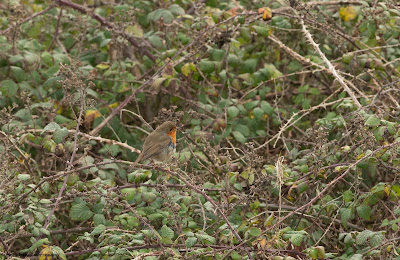An overnight light frost followed by a dry and often sunny day. Very light NW to NE breeze (calm at times)
Heysham skear - low water 09:05 (MD)
Pink-Footed Goose 735 in 10 north bound skeins between 08:00 and 08:55
Shelduck 1 north
I mentioned last night that I will be able to get further out this morning than I have since autumn. Not only further out but further south and north too. I took the south side heading out. The going was very difficult, the honeycomb worm beds and reefs have grown here, and they are not easy to traverse.
 |
| This is what laid ahead of me, some of these beds are 1.5m high. |
Shag 1 immature feeding just out from the southern honeycomb worm beds. The gull has a small starfish. At this size they try to swallow them whole.
The honeycomb worm beds thinned out after about 250m after that the winter storms have stripped all the mussels. All that remains are the rocks of the skear bottom and banks of broken shells. It took 45 minutes to reach the first channel. This is as far as you can go in just wellies, it's a mile from the shore, and it only takes 25-30 minutes as a rule.
 |
First channel, with bare banks on both sides. To the left is the start of the
outer skear, on the right is the end of the middle skear |
So, the honeycomb worms have survived and the mussels have gone. There are also extensive honeycomb worm reefs on the north side. This is what today's title refers to. The battle for ownership of the skear between the mussels and honeycomb worm begins here. The honeycomb worm have the advantage of, first, still being here, and then the opportunity to spread further before the seed mussels arrive in spring. But when the seed mussels do arrive they arrive en masse and can smother everything. Unfortunately (for the mussels) the seed mussels attract large numbers of gulls (mainly Herring) that feed on them. I look forward to watching the battle unfold.
Knot 350 in small flocks
 |
Knot and a couple of Dunlin. But this shot is not about the birds, it's just to show how beautiful it
is out here on a nice morning. The dark banks just behind the Knot are Honeycomb worm reefs |
Cormorant 18 at least feeding and many seen catching flounders. This one has a large one but quickly released it. It is just about on the limit of what they can swallow and they normally try, but it was being harassed and I suspect it knew there were plenty of more suitable sized flatties around.
 |
| Cormorant with a large Flounder |
Eider 38
Wigeon 2
The lack of mussels here is not a problem for the Eider at the moment. This clip of Eider and Wigeon starts with a female Eider eating a crab. She then catches and eats another all within 30 seconds!
Great Crested Grebe 6
Red-breasted Merganser 19
By this time the tide was coming in quickly and concentrating the birds. This clip starts with preening Eider, then feeding Merganser, Cormorants resting after feeding and a feeding Cormorant with a more conservative sized flattie.
 |
| Just a small, section of the north side honeycomb worm reefs |
Tides do not come in and out at a regular pace, they begin by coming in slowly, then start to speed up before slowing down again before high water. It was now 90 minutes flood and it was coming in very quickly.
Time to leave!
South shore- high water 14:40 (MD)
Just a check of Red Nab to the saltmarsh towards high water
Pale-bellied Brent goose 18 arrived at 13:00 and also seen flying south at 13:50. These are them arriving at Red Nab.
Shelduck 8
Wigeon c200
Rock Pipit 4 - 1 on Red Nab, 1 + 2 together on saltmarsh
Reed Bunting 8
Skylark 1
Nature Park
This Jay was retrieving some buried nuts near the newt pond.
 |
There are three finch species in this shot. Male and female Bullfinch, two Greenfinch
and a Goldfinch. You will probably need to open the image to see the detail. |
























































